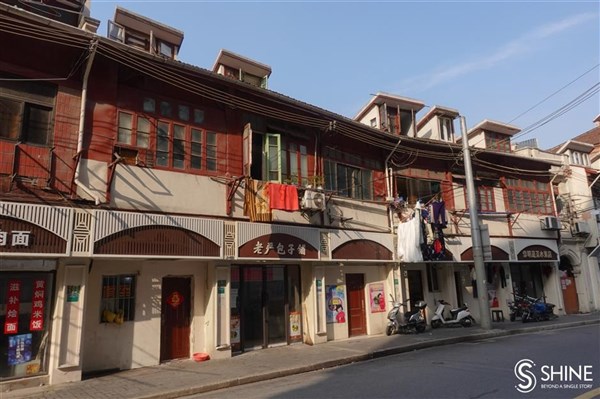Shanghai Today
Shanshouli residents make way for developers - June 05, 2020
上海北外滩山寿里项目旧改生效

Over 2,500 households will be relocated from a historical neighborhood on the North Bund to give way to the new round of redevelopment on the Huangpu River waterfront.
The relocation was launched on Thursday at the Shanshouli neighborhood, a typical old lane-style neighborhood built around the 1920s, after almost 98 percent of its residents signed a contract to be relocated with a cash subsidy from the government.
Most of the houses in the neighborhood, covering a total of 110,000 square meters on Jiulong, Daming, Wuchang and Hanyang roads in Hongkou District, will be protected after residents move out to preserve one of the city’s most typical living environments, according to the planning authority of Hongkou.
There are four historic sites within the neighborhood which are under protective status.
They include the former site of the Tanggu Road Secret Radio Station of the Communist Party of China, a historical warehouse of the city’s early ironmongery and electromechanical company, the former site of the Hongkou Police Station and a church built in 1870.
On the map of the North Bund, Shanshouli resembles a butterfly sitting in the core area of the waterfront, which is planned to be a central activity zone and a "new engine" for Shanghai's future development. The neighborhood gained fame after a popular television series “I Will Find You a Better Home” shot scenes there.
“The neighborhood has retained much of the old Shanghai vibe from the view of outsiders, but the residents are actually eager to be relocated due to the poor living conditions,” said Zhang Qiurong, Party secretary of the Tanghan Neighborhood Committee of Beiwaitan, or North Bund, subdistrict.
Residents living in cramped quarters, using chamber pots and coal stoves. They have to share kitchens and bathrooms because of the limited living space.
Li Jinfeng, a resident at 124 Tanggu Road, has been living in a 9.8-square-meter room with her son for over two decades. She cooks in a corridor and shares a bathroom with her neighbor.
“I would abandon most of the old furniture and belongings to prepare for the relocation,” said Li. Despite the limited space, Li arranged her apartment in order – a refrigerator, two beds and a foldable table are placed in the “living section,” while an overhead cable is used to hang clothes.
She was often frightened by mice dropped from the ceiling after she got married and moved in, but had become accustomed to the creatures, she said.
“It is a good opportunity for the new development of the North Bund as well as a new chance for me to start a new better life,” Li said.
Zhang said residents had been calling to confirm and ask about the relocation plan since last month. Li took her son to the relocation office to sign her contract even before the relocation process began.
To avoid infection during the coronavirus pandemic, the relocation office has created a non-contact method to communicate and explain policies to the residents, said Liu Feng, a general manager with the office.
“Staff in 46 groups communicated with residents through WeChat, phone and video calls,” Liu said.
All households will receive a cash subsidy to purchase other properties.
Most of the residents are elderly and the relocation office has tried to figure out the best compensation measures for each household, Liu said.
A couple over the age of 70 who are disabled, for instance, finally agreed a relocation deal after patient explanation by relocation staff. They had refused at first because they lived close to Shanghai General Hospital, which they often visited.
A total of 6,000 households will be relocated from the old neighborhoods on the North Bund by the end of the year.
The riverside region, covering about 4 square kilometers, will be on a par with the Lingang Special Area and the Pudong New Area in the east, and the demonstration zone for the integrated development of the Yangtze River Delta region and the Hongqiao Business District in the west, said Wu Xinbao, Party secretary of Hongkou.
According to the blueprint, the North Bund will include a core central business district with a high density of office buildings and commercial facilities along with historical and cultural regions around the Tilanqiao and Hongkougang River, where the historical ambiance will be preserved.
"The North Bund will also become the new landmark to lead the city's north-south development axis as well as the new benchmark for urban development in the new era," Wu said.
Application Status
| 04-16 | 21315227 | Processing |
| 03-12 | 21315226 | Processing |
| 09-26 | 21315225 | Processing |
Inquiry Status
| 02-29 | 02131558 | Received |
| 03-06 | 02131557 | Received |
| 11-14 | 02131556 | Received |
FAQ
Q: Q: Is there a place where I can get...
A: A: Log on to http://touch.shio.gov....
A: A: Log on to http://touch.shio.gov....
Q: Q: What is the easiest way to set u...
A: A: 1. Log on to http://touch.shio.g...
A: A: 1. Log on to http://touch.shio.g...
Q: Where can I get an English map of S...
A: English maps of Shanghai are availa...
A: English maps of Shanghai are availa...

